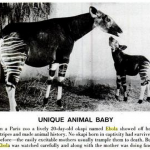okapi
I used Google N-gram Viewer to inspect the occurrence of the word "Ebola" in the Google-indexed literature. A few instances of Ebola came up earlier than the disease being known, so I figured they were references to the place name in Zaire/Congo, after which the disease is named. And that was in fact the case. But, of handful of early instances I checked out, two were interesting.
The Ngram is above. Note that I have smoothing set to zero, which I recommend, and I've got the date set for early on in the use of the term so pre-disease uses are more visible.
The two interesting instances I…
"That is Shadowfax. He is chief of the Maeras, lords of all horses, and not even Theoden, King of Rohan, has ever looked on a better. Does he not shine like silver, and run as smoothly as a swift stream?" - Gandalf
In the Lord of the Rings, Gandalf rides upon a magnificent white stallion called Shadowfax. White horses have been greatly prized in human societies as a sign of wealth and dignity, largely because their bright coats are both pretty and rare. There are reasons for that. In the wild, the same conspicuousness that inspires legendary tales also makes white horses vulnerable to…
Well, not really lies, but untruths. As perhaps the only person blogging on Scienceblogs.com who has actually eaten an okapi (Okapi johnstoni), I feel the need to clarify some misconceptions that are floating around about this beast.
If you go to the Sb home page, you'll find numerous links to the current Okapi story, about how the first photographs of a wild okapi have been obtained, and how the okapi was thought to have been wiped out due to the current civil war. I do not have time to write extensively about this right now, but I'll make a few points.
First, it is not the case that wild…
A quick wrap-up of the animals discovered not to be extinct this week:
Armoured mistfrog
This Armoured Mistfrog, thought by many experts to be extinct due to the recent amphibian chytrid fungus epidemic, was rediscovered by my boss, enterprise search god, Chris Cleveland, while he should have been working, on CNN. And more specifically, in a remote tropical area in northern Australia.
Tadpole Shrimp
Heavy rains in Scotland have created perfect conditions for the reemergence of the tadpole shrimp, thought extinct in the UK until recently. The little critter resembles a tiny horseshoe crab…
tags: Okapi, Okapia johnstoni, camera trap, zoology, rare mammals, Democratic Republic of Congo, Congo rainforest, African Wildlife, Zoological Society of London
This undated image provided by the Zoological Society of London, Thursday, 11 September 2008, shows an okapi, Okapia johnstoni, in Virunga National Park in the Democratic Republic of the Congo proving that the species is still surviving there despite more than one decade of civil conflict. The Zoological Society of London says cameras set up in Congo have snapped the first photos of the rare okapi roaming wild. Okapi have…
Two weeks ago, we asked you what your favoritest animals in the world were. Then, last week we asked you to up the ante and get weirder. You responded in turn with a veritable cornucopia of odd critters some of which we had never heard of! (Just kidding of course we'd heard of them, we're like freaking bizarre animal encyclopedias.)
Anyway, without further ado, your responses (in video, whenever possible):
Drhoz! wants to cuddle with a tardigrade, aka a 'water bear.' Who doesn't?
Unfortunately, Drhoz! also claims to...
... be open to "shacking up" with a goose barnacle if it buys dinner…
The photo I posted yesterday of a male Gerenuk (Litocranius walleri) has prompted some discussion about other long-necked artiodactyls, especially the living representatives of the family Giraffidae. Although the family once contained more members (like the oddly-ornamented Sivatherium), only the Giraffe (Giraffa camelopardalis) and the Okapi (Okapia johnstoni) are extant. Pictured above is a female Okapi at the Bronx Zoo, the distinction between the sexes being easily distinguished as the female lacks the skin-covered protrusions made of ossified cartilage known as "ossicones" that are…
